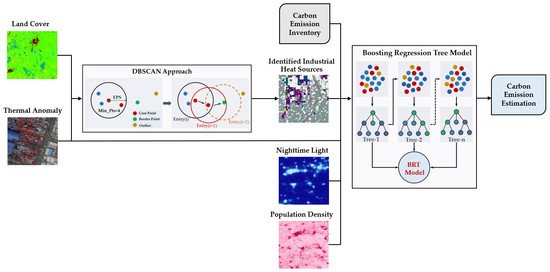Estimating the Carbon Emissions of Remotely Sensed Energy-Intensive Industries Using VIIRS Thermal Anomaly-Derived Industrial Heat Sources and Auxiliary Data
Abstract
:1. Introduction
2. Materials and Methods
2.1. Study Area
2.2. Data Sources and Materials
2.2.1. VIIRS-Derived Thermal Anomaly Product
2.2.2. ESA_CCI Land Cover Dataset
2.2.3. Remotely Sensed Nighttime Light (NTL) and Gridded Population Data
2.2.4. Reference IHS Patches
2.2.5. Corporation-Level Inventory Data
2.3. Workflow
2.4. Data Processing and Analysis
2.4.1. Identification of IHSs
2.4.2. Characterization of IHSs
2.4.3. Accuracy Assessment of IHSs
2.5. Estimation of Industrial Carbon Emissions
2.5.1. BRT Modeling
2.5.2. Accuracy Assessment
3. Results
3.1. Identification of IHSs
3.2. Comparison with the Referenced IHSs
3.3. Comparison with Corporate Inventory Data
3.4. BRT Modeling Performance Evaluation
4. Discussion
5. Conclusions
Author Contributions
Funding
Data Availability Statement
Conflicts of Interest
Appendix A
| Code | Industry Sector |
|---|---|
| B | Mining |
| 06 | Mining and Washing of Coal Industry |
| 07 | Extraction of Petroleum and Natural Gas |
| 08 | Ferrous Metal Mining and Selection Industry |
| 09 | Nonferrous Metal Mining and Selection Industry |
| 10 | Nonmetallic Mining and Selection Industry |
| 11 | Mining Professional and Auxiliary Activities |
| 12 | Other Mining Industry |
| C | Manufacturing |
| 13 | Processing of Food from Agricultural Products |
| 14 | Manufacture of Foods |
| 15 | Manufacture of Beverages |
| 16 | Manufacture of Tobacco |
| 17 | Manufacture of Textile |
| 18 | Manufacture of Textile Wearing Apparel, Footwear, and Caps |
| 19 | Manufacture of Leather, Fur, Feather, and Related Products |
| 20 | Processing of Timber, Manufacture of Wood, Bamboo, Rattan, Palm, and Straw Products |
| 21 | Manufacture of Furniture |
| 22 | Manufacture of Paper and Paper Products |
| 23 | Printing, Reproduction of Recording Media |
| 24 | Manufacture of Articles for Culture, Education, and Sport Activities |
| 25 | Processing of Petroleum, Coking, Processing of Nuclear Fuel |
| 26 | Manufacture of Raw Chemical Materials and Chemical Products |
| 27 | Manufacture of Medicines |
| 28 | Manufacture of Chemical Fibers |
| 29 | Manufacture of Rubber and Plastics |
| 30 | Manufacture of Nonmetallic Mineral Products |
| 31 | Smelting and Pressing of Ferrous Metals |
| 32 | Smelting and Pressing of Nonferrous Metals |
| 33 | Manufacture of Metal Products |
| 34 | Manufacture of General Purpose Machinery |
| 35 | Manufacture of Special Purpose Machinery |
| 36 | Manufacture of Automobile |
| 37 | Manufacture of Railways, Shipbuilding, Aerospace, and Other Transportation Equipment |
| 38 | Manufacture of Electrical Machinery and Equipment |
| 39 | Manufacture of Communication Equipment, Computers, and Other Electronic Equipment |
| 40 | Manufacture of Measuring Instruments and Machinery for Cultural Activity and Office Work |
| 41 | Manufacture of Artwork and Other Manufacturing |
| 42 | Recycling and Disposal of Waste |
| 43 | Repair and Installation of Machinery and Equipment |
| D | Production and Supply of Electricity, Gas, and Water |
| 44 | Production and Supply of Electric Power and Heat Power |
| 45 | Production and Supply of Gas |
| 46 | Production and Supply of Tap Water |
| Energy Type | Conversion Factor to SCE (Unit: tSCE/t) | Carbon Emission Factor (×104 tC/104 tSCE) |
|---|---|---|
| CFSCE | CEF | |
| Raw Coal | 0.7143 | 0.7559 |
| Coke | 0.9714 | 0.855 |
| Natural Gas * | 1.33 | 0.4483 |
| Electricity * | - | 0.272 |
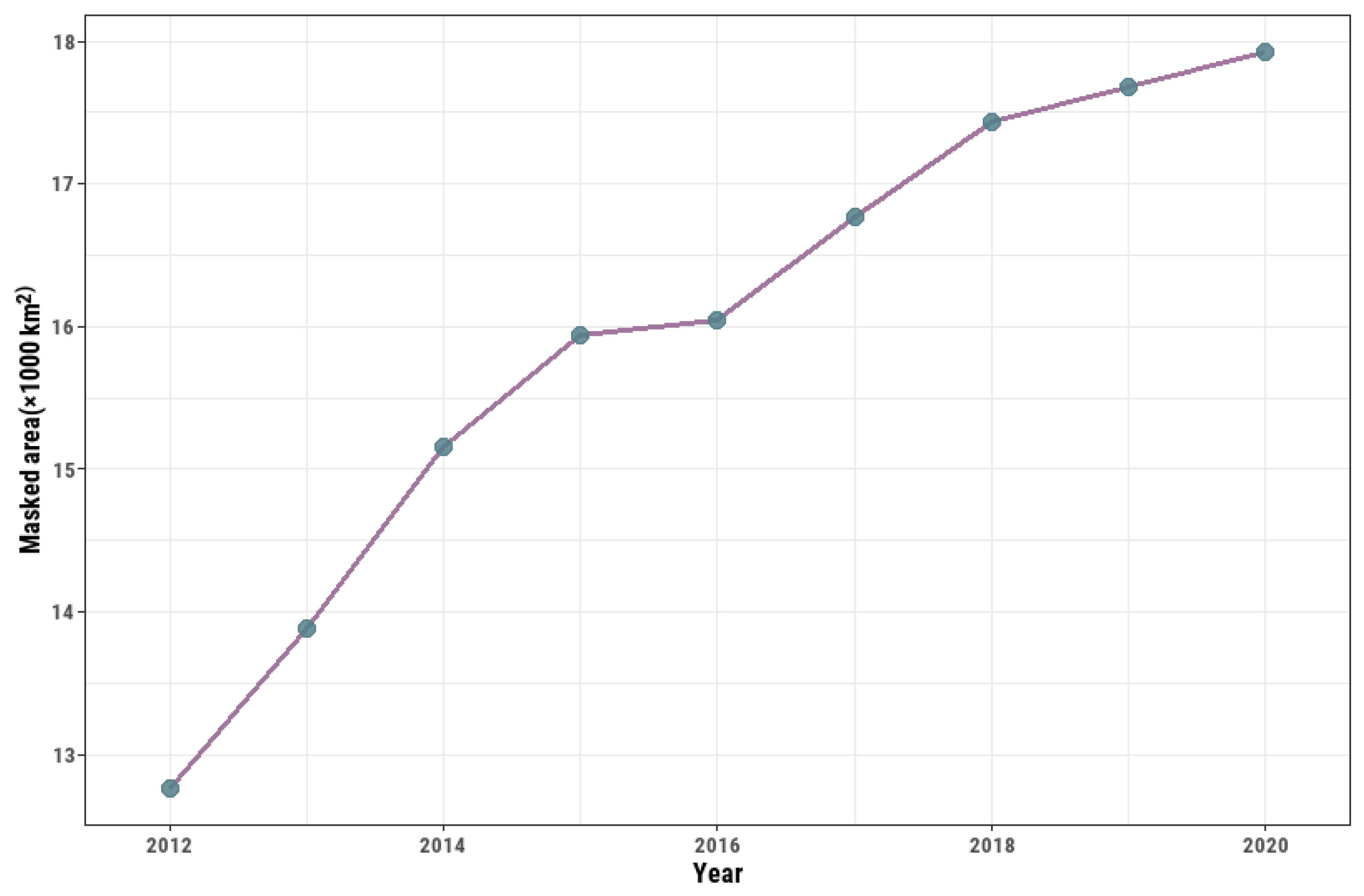
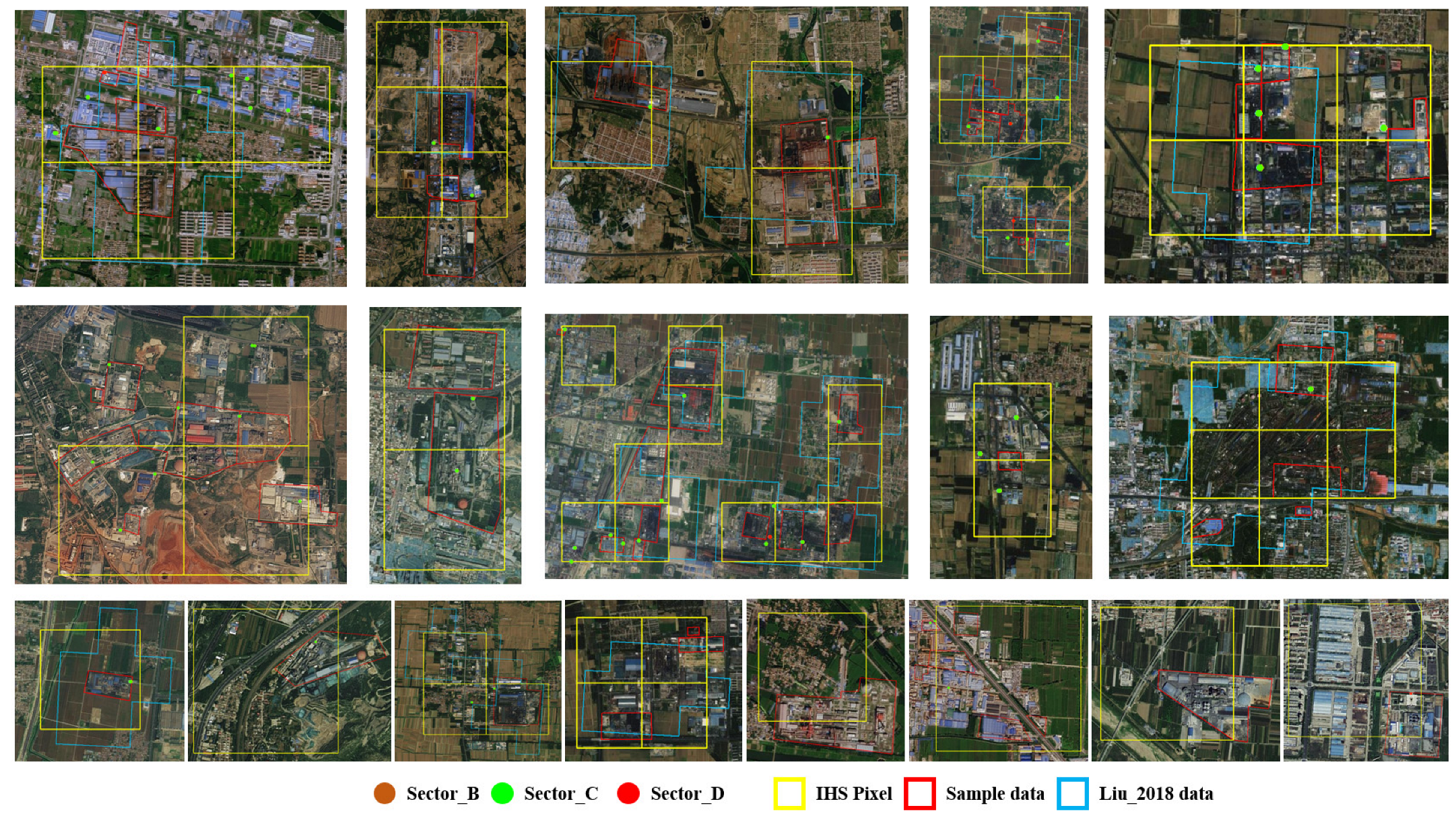
References
- Guo, J.; Su, T.; Chen, D.; Wang, J.; Li, Z.; Lv, Y.; Guo, X.; Liu, H.; Cribb, M.; Zhai, P. Declining Summertime Local-Scale Precipitation Frequency Over China and the United States, 1981–2012: The Disparate Roles of Aerosols. Geophys. Res. Lett. 2019, 46, 13281–13289. [Google Scholar] [CrossRef] [Green Version]
- Hoegh-Guldberg, O.; Jacob, D.; Taylor, M.; Bolanos, T.G.; Bindi, M.; Brown, S.; Camilloni, I.A.; Diedhiou, A.; Djalante, R.; Ebi, K.; et al. The human imperative of stabilizing global climate change at 1.5 degrees C. Science 2019, 365, 1263. [Google Scholar] [CrossRef] [PubMed] [Green Version]
- Burke, S.E.L.; Sanson, A.V.; Van Hoorn, J. The Psychological Effects of Climate Change on Children. Curr. Psychiatry Rep. 2018, 20, 1–8. [Google Scholar] [CrossRef] [PubMed]
- Sintayehu, D.W. Impact of climate change on biodiversity and associated key ecosystem services in Africa: A systematic review. Ecosyst. Health Sustain. 2018, 4, 225–239. [Google Scholar] [CrossRef] [Green Version]
- Mengel, M.; Nauels, A.; Rogelj, J.; Schleussner, C.F. Committed sea-level rise under the Paris Agreement and the legacy of delayed mitigation action. Nat. Commun. 2018, 9, 601. [Google Scholar] [CrossRef] [Green Version]
- Rosen, M.A. Energy Sustainability with a Focus on Environmental Perspectives. Earth Syst. Environ. 2021, 5, 217–230. [Google Scholar] [CrossRef]
- IPCC. Climate Change 2022: Mitigation of Climate Change. Contribution of Working Group III to the Sixth Assessment Report of the Intergovernmental Panel on Climate Change; IPCC: Cambridge, UK; New York, NY, USA, 2022. [Google Scholar]
- Shan, Y.L.; Guan, D.B.; Zheng, H.R.; Ou, J.M.; Li, Y.; Meng, J.; Mi, Z.F.; Liu, Z.; Zhang, Q. Data Descriptor: China CO2 emission accounts 1997–2015. Sci. Data 2018, 5, 170201. [Google Scholar] [CrossRef] [Green Version]
- Wang, S.; Zhang, Y.; Hakkarainen, J.; Ju, W.; Liu, Y.; Jiang, F.; He, W. Distinguishing Anthropogenic CO2 Emissions From Different Energy Intensive Industrial Sources Using OCO-2 Observations: A Case Study in Northern China. J. Geophys. Res.-Atmos. 2018, 123, 9462–9473. [Google Scholar] [CrossRef]
- Liu, F.; Zhang, Q.; Tong, D.; Zheng, B.; Li, M.; Huo, H.; He, K. High-resolution inventory of technologies, activities, and emissions of coal-fired power plants in China from 1990 to 2010. Atmos. Chem. Phys. 2015, 15, 13299–13317. [Google Scholar] [CrossRef] [Green Version]
- Sekertekin, A.; Arslan, N. Monitoring thermal anomaly and radiative heat flux using thermal infrared satellite imagery-A case study at Tuzla geothermal region. Geothermics 2019, 78, 243–254. [Google Scholar] [CrossRef]
- Elvidge, C.D.; Baugh, K.; Zhizhin, M.; Hsu, F.C.; Ghosh, T. VIIRS night-time lights. Int. J. Remote Sens. 2017, 38, 5860–5879. [Google Scholar] [CrossRef]
- Giglio, L.; Csiszar, I.; Restás, Á.; Morisette, J.T.; Schroeder, W.; Morton, D.; Justice, C.O. Active fire detection and characterization with the advanced spaceborne thermal emission and reflection radiometer (ASTER). Remote Sens. Environ. 2008, 112, 3055–3063. [Google Scholar] [CrossRef]
- Schroeder, W.; Oliva, P.; Giglio, L.; Csiszar, I.A. The New VIIRS 375 m active fire detection data product: Algorithm description and initial assessment. Remote Sens. Environ. 2014, 143, 85–96. [Google Scholar] [CrossRef]
- Schroeder, W.; Oliva, P.; Giglio, L.; Quayle, B.; Lorenz, E.; Morelli, F. Active fire detection using Landsat-8/OLI data. Remote Sens. Environ. 2016, 185, 210–220. [Google Scholar] [CrossRef] [Green Version]
- Chuvieco, E.; Lizundia-Loiola, J.; Lucrecia Pettinari, M.; Ramo, R.; Padilla, M.; Tansey, K.; Mouillot, F.; Laurent, P.; Storm, T.; Heil, A.; et al. Generation and analysis of a new global burned area product based on MODIS 250 m reflectance bands and thermal anomalies. Earth Syst. Sci. Data 2018, 10, 2015–2031. [Google Scholar] [CrossRef] [Green Version]
- Earl, N.; Simmonds, I. Spatial and Temporal Variability and Trends in 2001-2016 Global Fire Activity. J. Geophys. Res.-Atmos. 2018, 123, 2524–2536. [Google Scholar] [CrossRef]
- Li, H.; Zhou, Y.; Li, X.; Meng, L.; Wang, X.; Wu, S.; Sodoudi, S. A new method to quantify surface urban heat island intensity. Sci. Total Environ. 2018, 624, 262–272. [Google Scholar] [CrossRef]
- Meng, Q.; Zhang, L.; Sun, Z.; Meng, F.; Wang, L.; Sun, Y. Characterizing spatial and temporal trends of surface urban heat island effect in an urban main built-up area: A 12-year case study in Beijing, China. Remote Sens. Environ. 2018, 204, 826–837. [Google Scholar] [CrossRef]
- Ahmed, S. Assessment of urban heat islands and impact of climate change on socioeconomic over Suez Governorate using remote sensing and GIS techniques. Egypt. J. Remote Sens. Space Sci. 2018, 21, 15–25. [Google Scholar] [CrossRef]
- Wang, W.M.; Liu, K.; Tang, R.; Wang, S.D. Remote sensing image-based analysis of the urban heat island effect in Shenzhen, China. Phys. Chem. Earth 2019, 110, 168–175. [Google Scholar] [CrossRef]
- Pan, Z.K.; Wang, G.X.; Hu, Y.M.; Cao, B. Characterizing urban redevelopment process by quantifying thermal dynamic and landscape analysis. Habitat Int. 2019, 86, 61–70. [Google Scholar] [CrossRef]
- Ma, C.H.; Yang, J.; Chen, F.; Ma, Y.; Liu, J.B.; Li, X.P.; Duan, J.B.; Guo, R. Assessing Heavy Industrial Heat Source Distribution in China Using Real-Time VIIRS Active Fire/Hotspot Data. Sustainability 2018, 10, 4419. [Google Scholar] [CrossRef] [Green Version]
- Ma, Y.; Ma, C.H.; Liu, P.; Yang, J.; Wang, Y.Z.; Zhu, Y.Q.; Du, X.P. Spatial-Temporal Distribution Analysis of Industrial Heat Sources in the US with Geocoded, Tree-Based, Large-Scale Clustering. Remote Sens. 2020, 12, 3069. [Google Scholar] [CrossRef]
- Ma, C.; Niu, Z.; Ma, Y.; Chen, F.; Yang, J.; Liu, J. Assessing the Distribution of Heavy Industrial Heat Sources in India between 2012 and 2018. Isprs Int. J. Geo-Inf. 2019, 8, 568. [Google Scholar] [CrossRef] [Green Version]
- Xia, H.P.; Chen, Y.H.; Quan, J.L. A simple method based on the thermal anomaly index to detect industrial heat sources. Int. J. Appl. Earth Obs. Geoinf. 2018, 73, 627–637. [Google Scholar] [CrossRef]
- Zhang, P.; Yuan, C.C.; Sun, Q.Q.; Liu, A.X.; You, S.C.; Li, X.W.; Zhang, Y.P.; Jiao, X.; Sun, D.F.; Sun, M.X.; et al. Satellite-Based Detection and Characterization of Industrial Heat Sources in China. Environ. Sci. Technol. 2019, 53, 11031–11042. [Google Scholar] [CrossRef]
- Liu, Y.; Hu, C.; Zhan, W.; Sun, C.; Murch, B.; Ma, L. Identifying industrial heat sources using time-series of the VIIRS Nightfire product with an object-oriented approach. Remote Sens. Environ. 2018, 204, 347–365. [Google Scholar] [CrossRef]
- Yang, D.X.; Liu, Y.; Cai, Z.N.; Chen, X.; Yao, L.; Lu, D.R. First Global Carbon Dioxide Maps Produced from TanSat Measurements. Adv. Atmos. Sci. 2018, 35, 621–623. [Google Scholar] [CrossRef]
- Yokota, T.; Yoshida, Y.; Eguchi, N.; Ota, Y.; Tanaka, T.; Watanabe, H.; Maksyutov, S. Global Concentrations of CO2 and CH4 Retrieved from GOSAT: First Preliminary Results. Sola 2009, 5, 160–163. [Google Scholar] [CrossRef] [Green Version]
- Janardanan, R.; Maksyutov, S.; Oda, T.; Saito, M.; Kaiser, J.W.; Ganshin, A.; Stohl, A.; Matsunaga, T.; Yoshida, Y.; Yokota, T. Comparing GOSAT observations of localized CO2 enhancements by large emitters with inventory-based estimates. Geophys. Res. Lett. 2016, 43, 3486–3493. [Google Scholar] [CrossRef] [Green Version]
- Hakkarainen, J.; Ialongo, I.; Tamminen, J. Direct space-based observations of anthropogenic CO2 emission areas from OCO-2. Geophys. Res. Lett. 2016, 43, 11400–11406. [Google Scholar] [CrossRef]
- Hedelius, J.K.; Feng, S.; Roehl, C.M.; Wunch, D.; Hillyard, P.; Podolske, J.R.; Iraci, L.T.; Patarasuk, R.; Rao, P.; O’Keeffe, D.; et al. Emissions and topographic effects on column CO2 (X-CO2) variations, with a focus on the Southern California Megacity. J. Geophys. Res.-Atmos. 2017, 122, 7200–7215. [Google Scholar] [CrossRef]
- Yang, S.; Lei, L.; Zeng, Z.; He, Z.; Zhong, H. An Assessment of Anthropogenic CO2 Emissions by Satellite-Based Observations in China. Sensors 2019, 19, 1118. [Google Scholar] [CrossRef] [PubMed] [Green Version]
- Lu, H.; Liu, G. Spatial effects of carbon dioxide emissions from residential energy consumption: A county-level study using enhanced nocturnal lighting. Appl. Energy 2014, 131, 297–306. [Google Scholar] [CrossRef]
- Oda, T.; Maksyutov, S. A very high-resolution (1 km × 1 km) global fossil fuel CO2 emission inventory derived using a point source database and satellite observations of nighttime lights. Atmos. Chem. Phys. 2011, 11, 543–556. [Google Scholar] [CrossRef] [Green Version]
- Liu, X.; Ou, J.; Wang, S.; Li, X.; Yan, Y.; Jiao, L.; Liu, Y. Estimating spatiotemporal variations of city-level energy-related CO2 emissions: An improved disaggregating model based on vegetation adjusted nighttime light data. J. Clean. Prod. 2018, 177, 101–114. [Google Scholar] [CrossRef]
- Yin, L.; Du, P.; Zhang, M.; Liu, M.; Xu, T.; Song, Y. Estimation of emissions from biomass burning in China (2003–2017) based on MODIS fire radiative energy data. Biogeosci. 2019, 16, 1629–1640. [Google Scholar] [CrossRef] [Green Version]
- Wiedinmyer, C.; Quayle, B.; Geron, C.; Belote, A.; McKenzie, D.; Zhang, X.; O’Neill, S.; Wynne, K.K. Estimating emissions from fires in North America for air quality modeling. Atmos. Environ. 2006, 40, 3419–3432. [Google Scholar] [CrossRef]
- Randerson, J.T.; Chen, Y.; van der Werf, G.R.; Rogers, B.M.; Morton, D.C. Global burned area and biomass burning emissions from small fires. J. Geophys. Res.-Biogeosci. 2012, 117, G04012. [Google Scholar] [CrossRef]
- van der Werf, G.R.; Randerson, J.T.; Giglio, L.; Collatz, G.J.; Mu, M.; Kasibhatla, P.S.; Morton, D.C.; DeFries, R.S.; Jin, Y.; van Leeuwen, T.T. Global fire emissions and the contribution of deforestation, savanna, forest, agricultural, and peat fires (1997–2009). Atmos. Chem. Phys. 2010, 10, 11707–11735. [Google Scholar] [CrossRef] [Green Version]
- Silvestri, M.; Cardellini, C.; Chiodini, G.; Buongiorno, M.F. Satellite-derived surface temperature and in situ measurement at Solfatara of Pozzuoli (Naples, Italy). Geochem. Geophys. Geosystems 2016, 17, 2095–2109. [Google Scholar] [CrossRef] [Green Version]
- Santoro, M.; Kirches, G.; Wevers, J.; Boettcher, M.; Brockmann, C.; Lamarche, C.; Defourny, P. Land Cover CCI: Product User Guide Version 2.0. 2017. Available online: maps.elie.ucl.ac.be/CCI/viewer/download/ESACCI-LC-Ph2-PUGv2_2.0.pdf (accessed on 4 November 2021).
- Zhao, M.; Zhou, Y.Y.; Li, X.C.; Cao, W.T.; He, C.Y.; Yu, B.L.; Li, X.; Elvidge, C.D.; Cheng, W.M.; Zhou, C.H. Applications of Satellite Remote Sensing of Nighttime Light Observations: Advances, Challenges, and Perspectives. Remote Sens. 2019, 11, 1971. [Google Scholar] [CrossRef] [Green Version]
- Yue, Y.L.; Tian, L.; Yue, Q.; Wang, Z. Spatiotemporal Variations in Energy Consumption and Their Influencing Factors in China Based on the Integration of the DMSP-OLS and NPP-VIIRS Nighttime Light Datasets. Remote Sens. 2020, 12, 1151. [Google Scholar] [CrossRef] [Green Version]
- Elvidge, C.D.; Baugh, K.E.; Kihn, E.A.; Kroehl, H.W.; Davis, E.R.; Davis, C.W. Relation between satellite observed visible-near infrared emissions, population, economic activity and electric power consumption. Int. J. Remote Sens. 1997, 18, 1373–1379. [Google Scholar] [CrossRef]
- Amaral, S.; Câmara, G.; Monteiro, A.M.V.; Quintanilha, J.A.; Elvidge, C.D. Estimating population and energy consumption in Brazilian Amazonia using DMSP night-time satellite data. Comput. Environ. Urban Syst. 2005, 29, 179–195. [Google Scholar] [CrossRef]
- Li, X.C.; Zhou, Y.Y.; Zhao, M.; Zhao, X. A harmonized global nighttime light dataset 1992–2018. Sci. Data 2020, 7, 168. [Google Scholar] [CrossRef]
- Andres, R.J.; Marland, G.; Fung, I.; Matthews, E. A 1 degrees x1 degrees distribution of carbon dioxide emissions from fossil fuel consumption and cement manufacture, 1950–1990. Glob. Biogeochem. Cycles 1996, 10, 419–429. [Google Scholar] [CrossRef]
- Hogue, S.; Roten, D.; Marland, E.; Marland, G.; Boden, T.A. Gridded estimates of CO2 emissions: Uncertainty as a function of grid size. Mitig. Adapt. Strateg. Glob. Chang. 2019, 24, 969–983. [Google Scholar] [CrossRef]
- Lloyd, C.T.; Chamberlain, H.; Kerr, D.; Yetman, G.; Pistolesi, L.; Stevens, F.R.; Gaughan, A.E.; Nieves, J.J.; Hornby, G.; MacManus, K.; et al. Global spatio-temporally harmonised datasets for producing high-resolution gridded population distribution datasets. Big Earth Data 2019, 3, 108–139. [Google Scholar] [CrossRef] [Green Version]
- Ester, M.; Kriegel, H.-P.; Sander, J.; Xu, X. A density-based algorithm for discovering clusters in large spatial databases with noise. Kdd 1996, 96, 226–231. [Google Scholar]
- Ester, M.; Kriegel, H.-P.; Sander, J.; Xu, X. Clustering for mining in large spatial databases. KI 1998, 12, 18–24. [Google Scholar]
- Schubert, E.; Sander, J.; Ester, M.; Kriegel, H.P.; Xu, X.W. DBSCAN Revisited, Revisited: Why and How You Should (Still) Use DBSCAN. Acm Trans. Database Syst. 2017, 42, 1–21. [Google Scholar] [CrossRef]
- Ertoz, L.; Steinbach, M.; Kumar, V. Finding clusters of different sizes, shapes, and densities in noisy, high dimensional data. In Proceedings of the 3rd SIAM International Conference on Data Mining, San Francisco, CA, USA, 1–3 May 2003; pp. 47–58. [Google Scholar]
- Elith, J.; Leathwick, J.R.; Hastie, T. A working guide to boosted regression trees. J. Anim. Ecol. 2008, 77, 802–813. [Google Scholar] [CrossRef] [PubMed]
- Lu, H.Y.; Price, L.; Zhang, Q. Capturing the invisible resource: Analysis of waste heat potential in Chinese industry. Appl. Energy 2016, 161, 497–511. [Google Scholar] [CrossRef] [Green Version]
- BoroumandJazi, G.; Rismanchi, B.; Saidur, R. A review on exergy analysis of industrial sector. Renew. Sustain. Energy Rev. 2013, 27, 198–203. [Google Scholar] [CrossRef]
- Zhao, N.; Samson, E.L.; Currit, N.A. Nighttime-Lights-Derived Fossil Fuel Carbon Dioxide Emission Maps and Their Limitations. Photogramm. Eng. Remote Sens. 2015, 81, 935–943. [Google Scholar] [CrossRef]
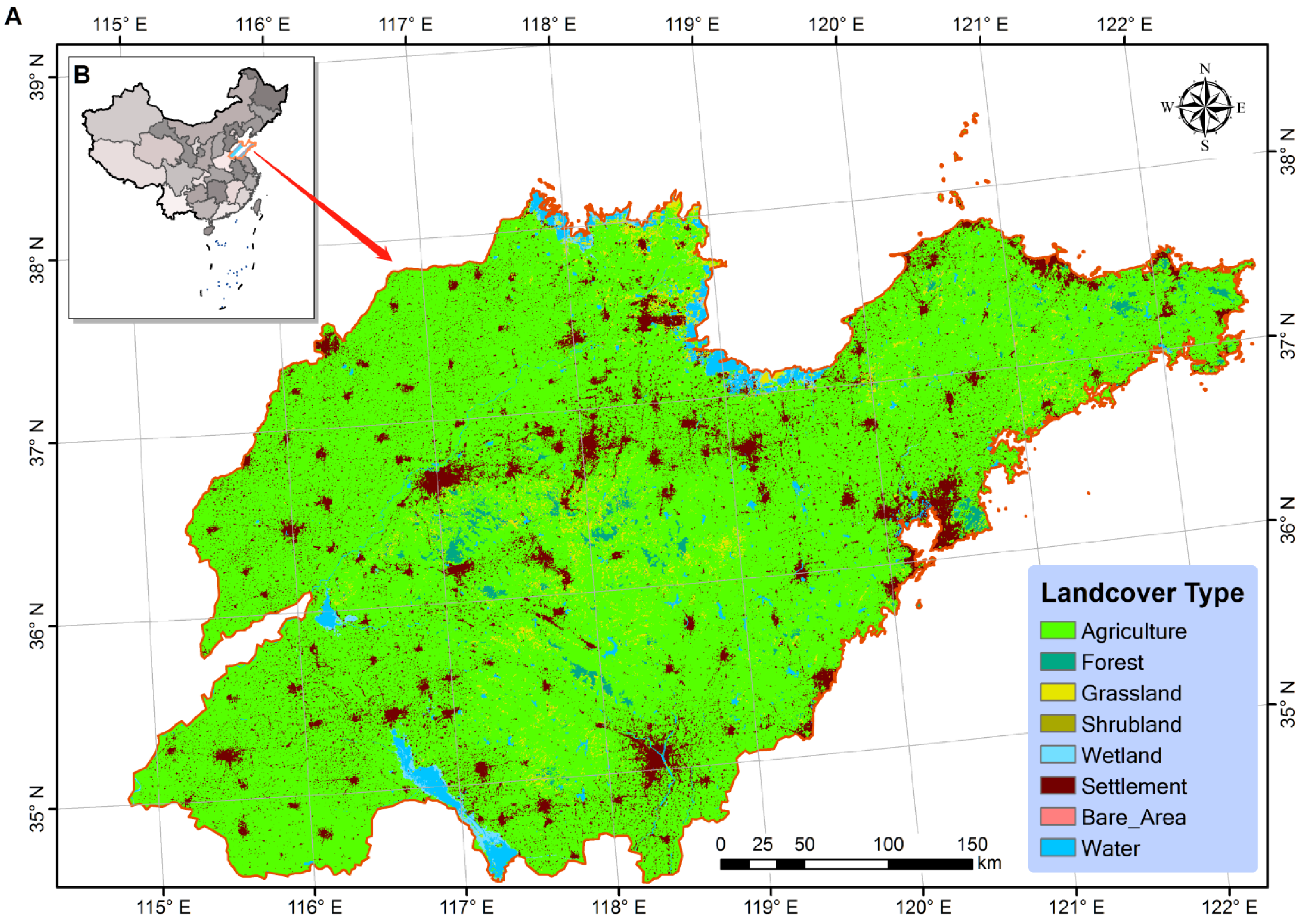
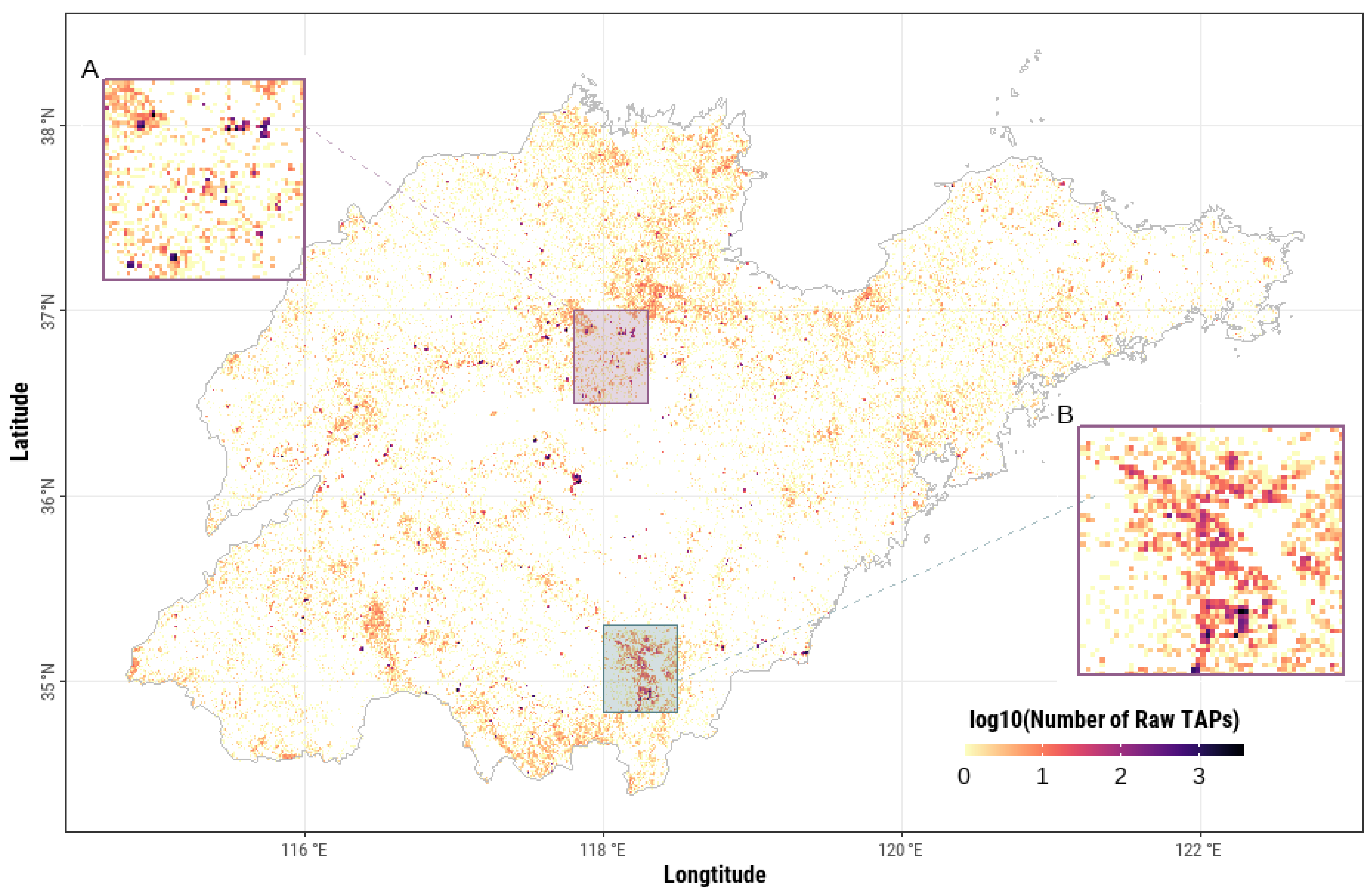
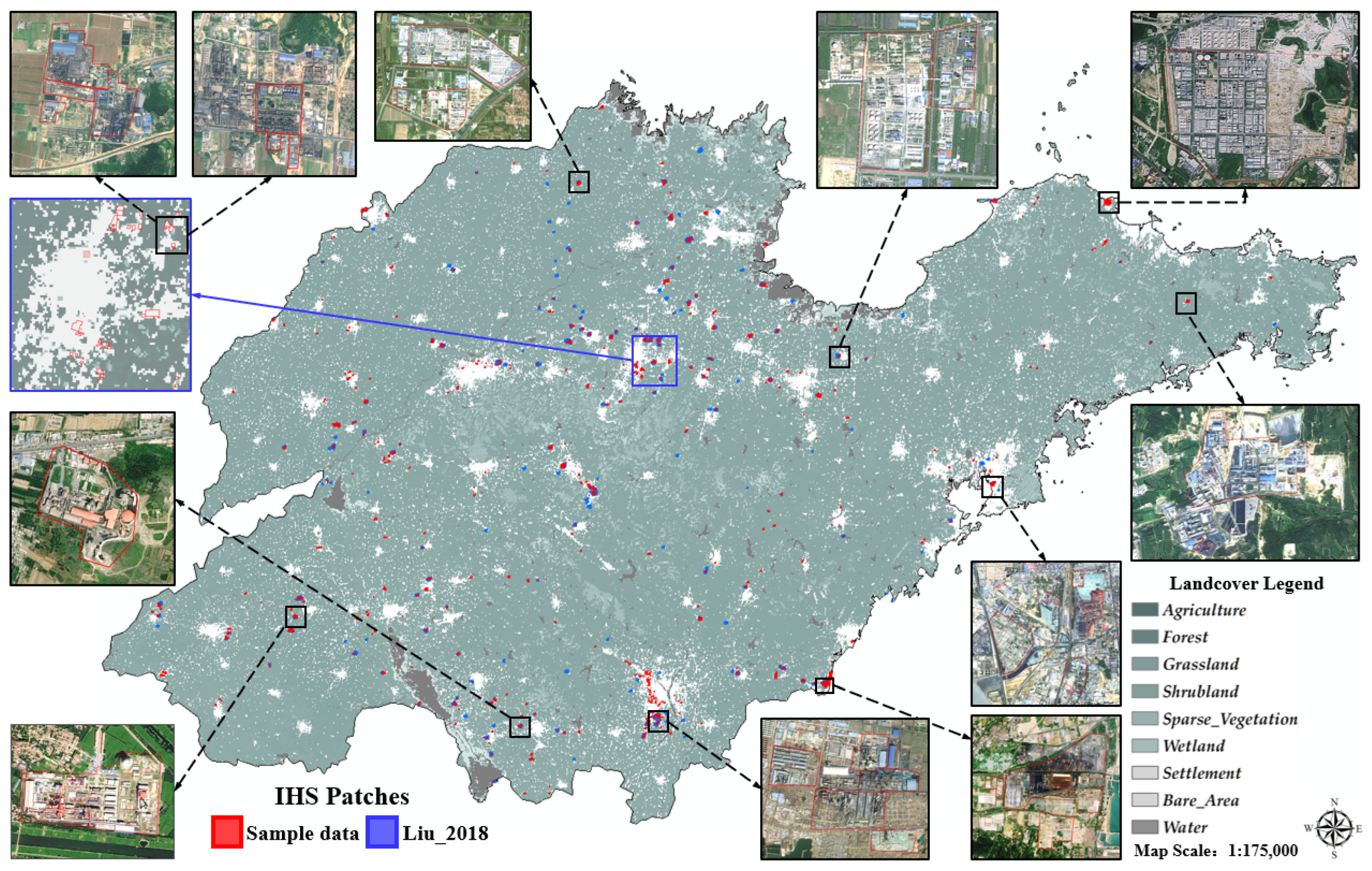
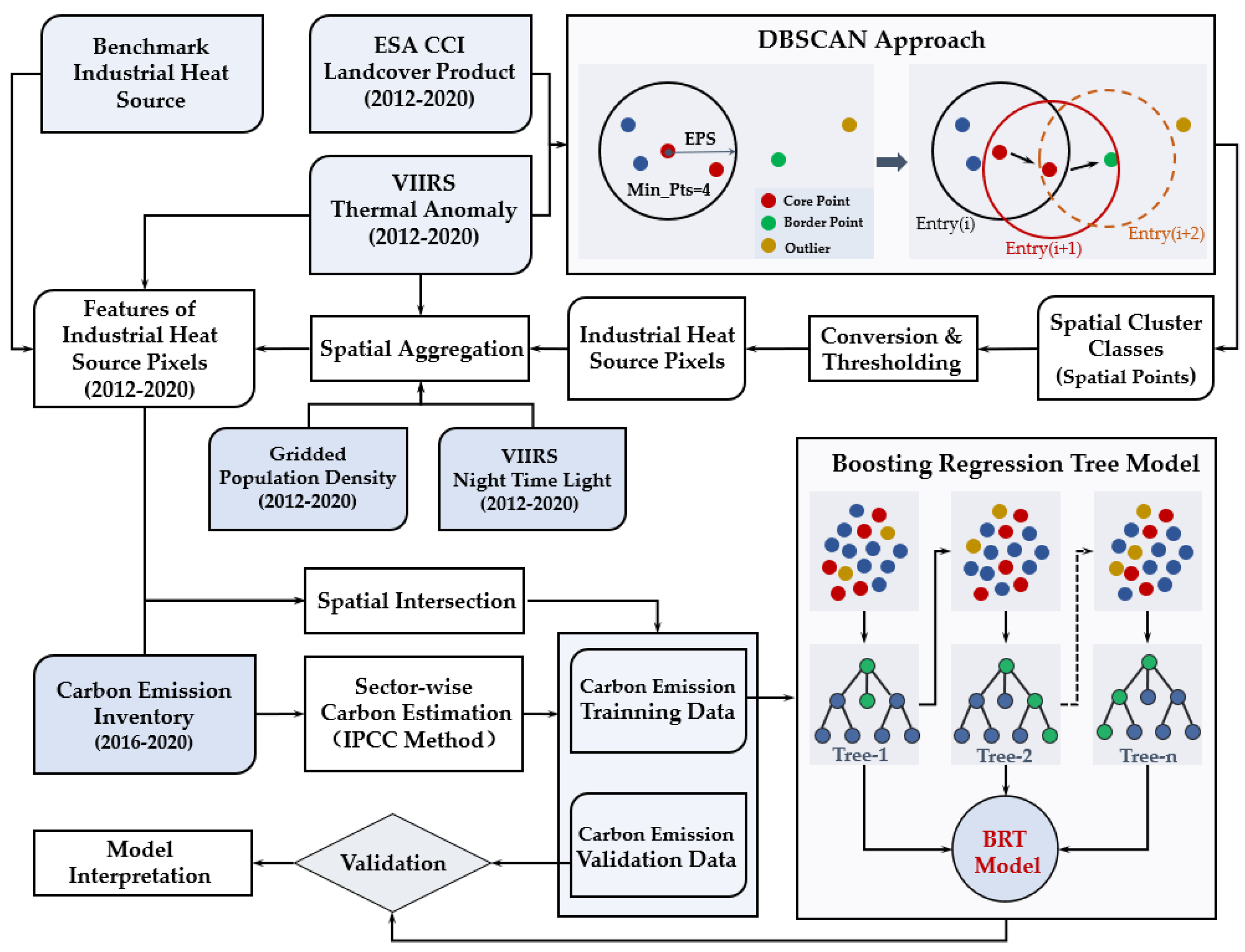
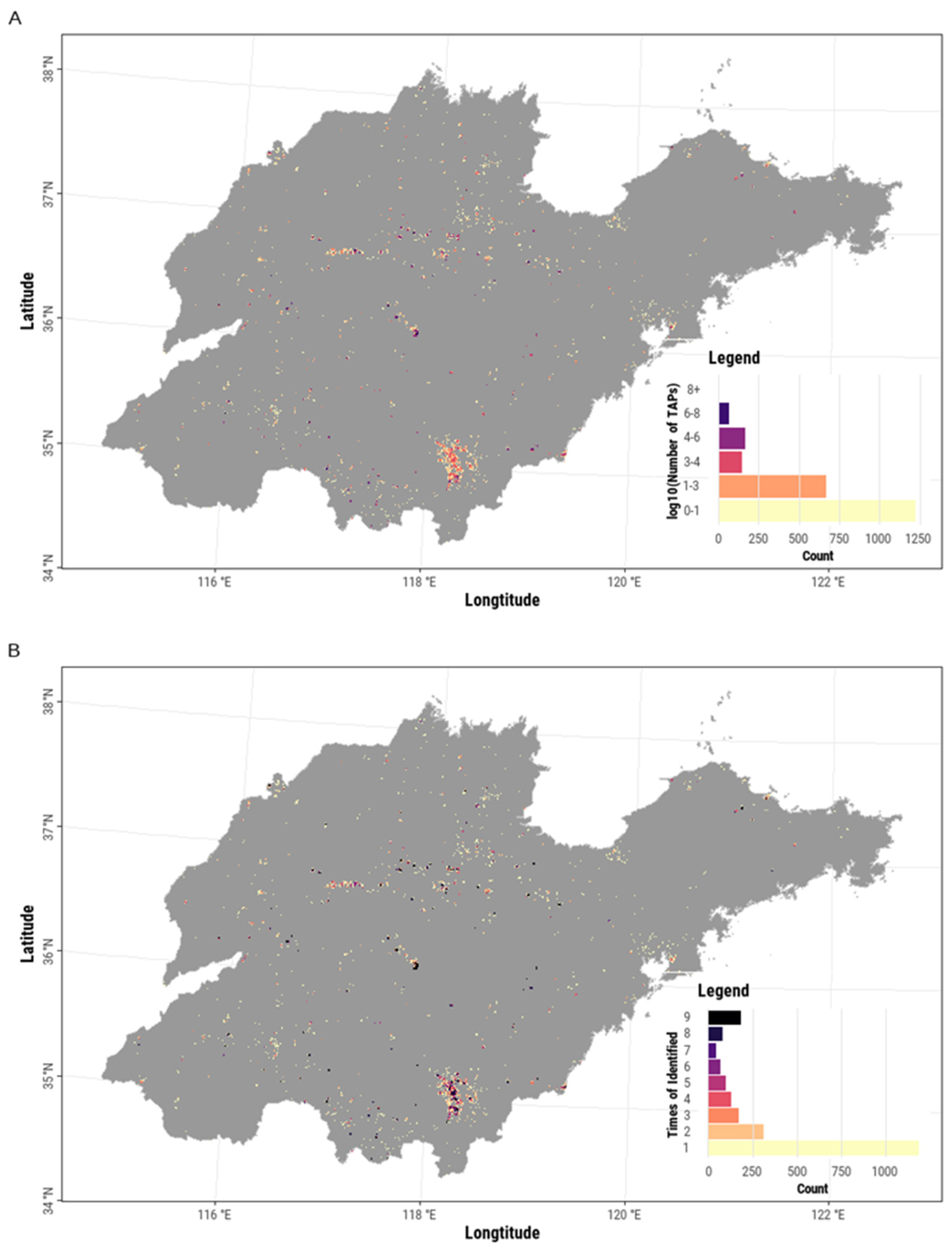
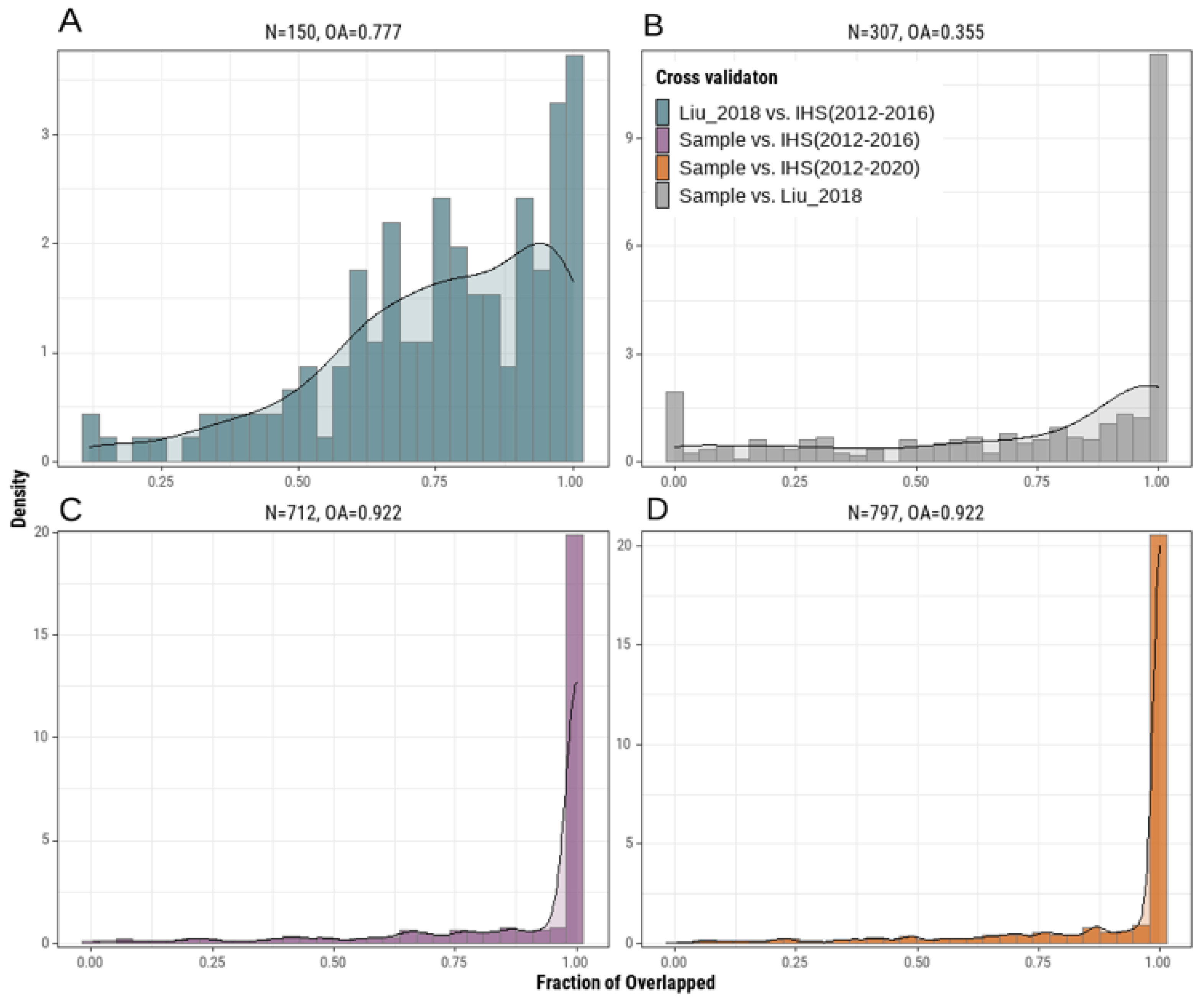
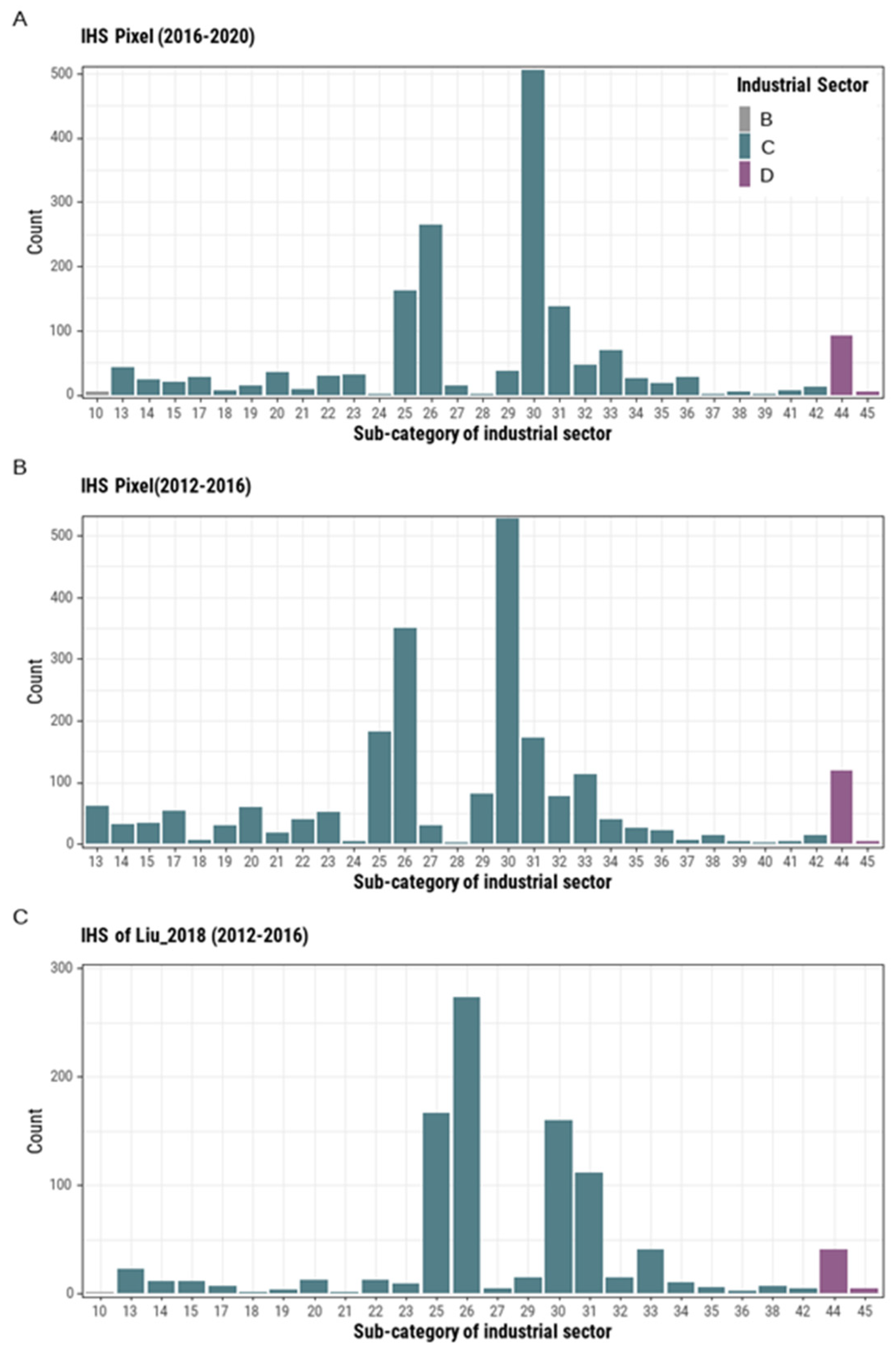
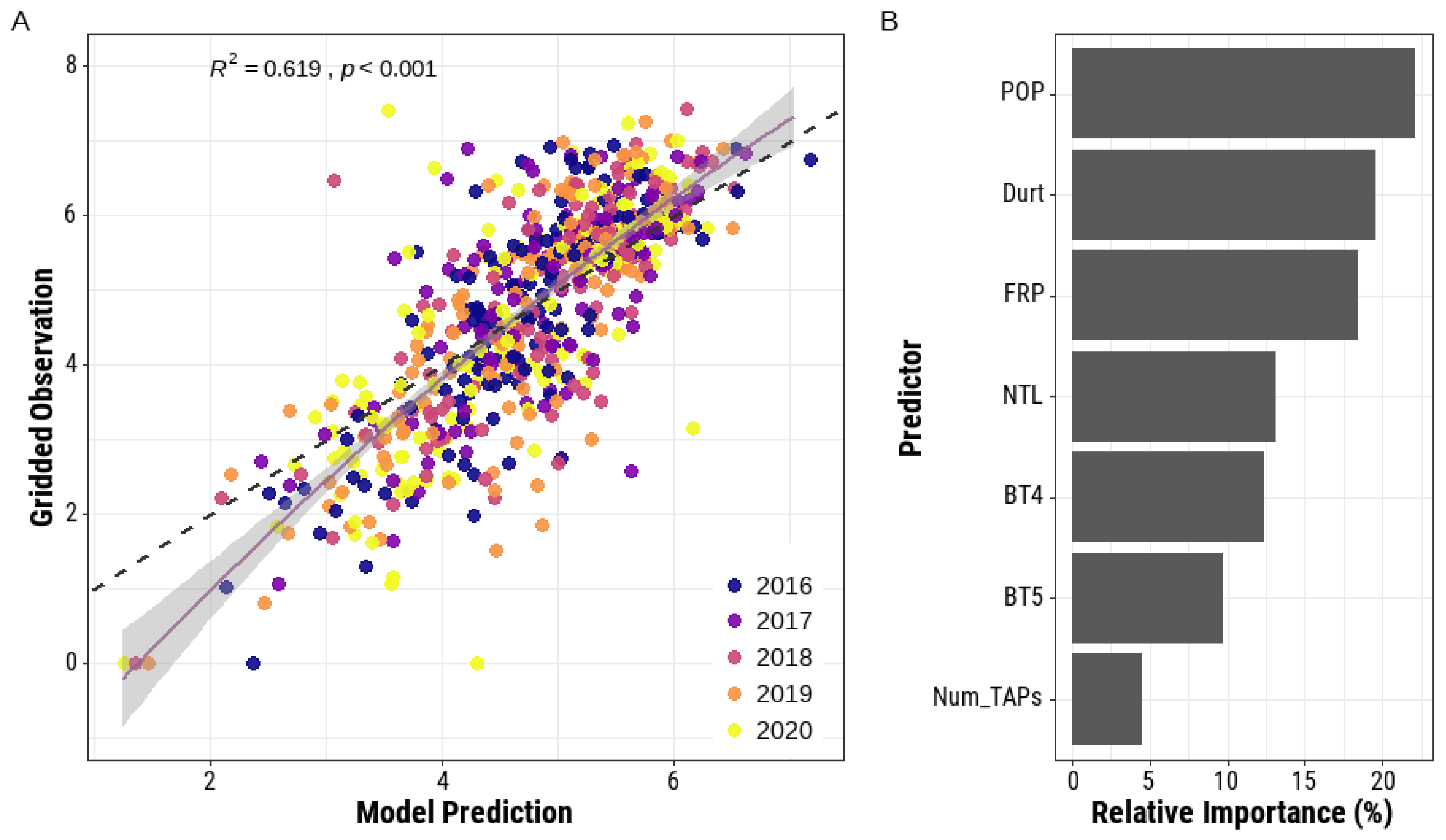
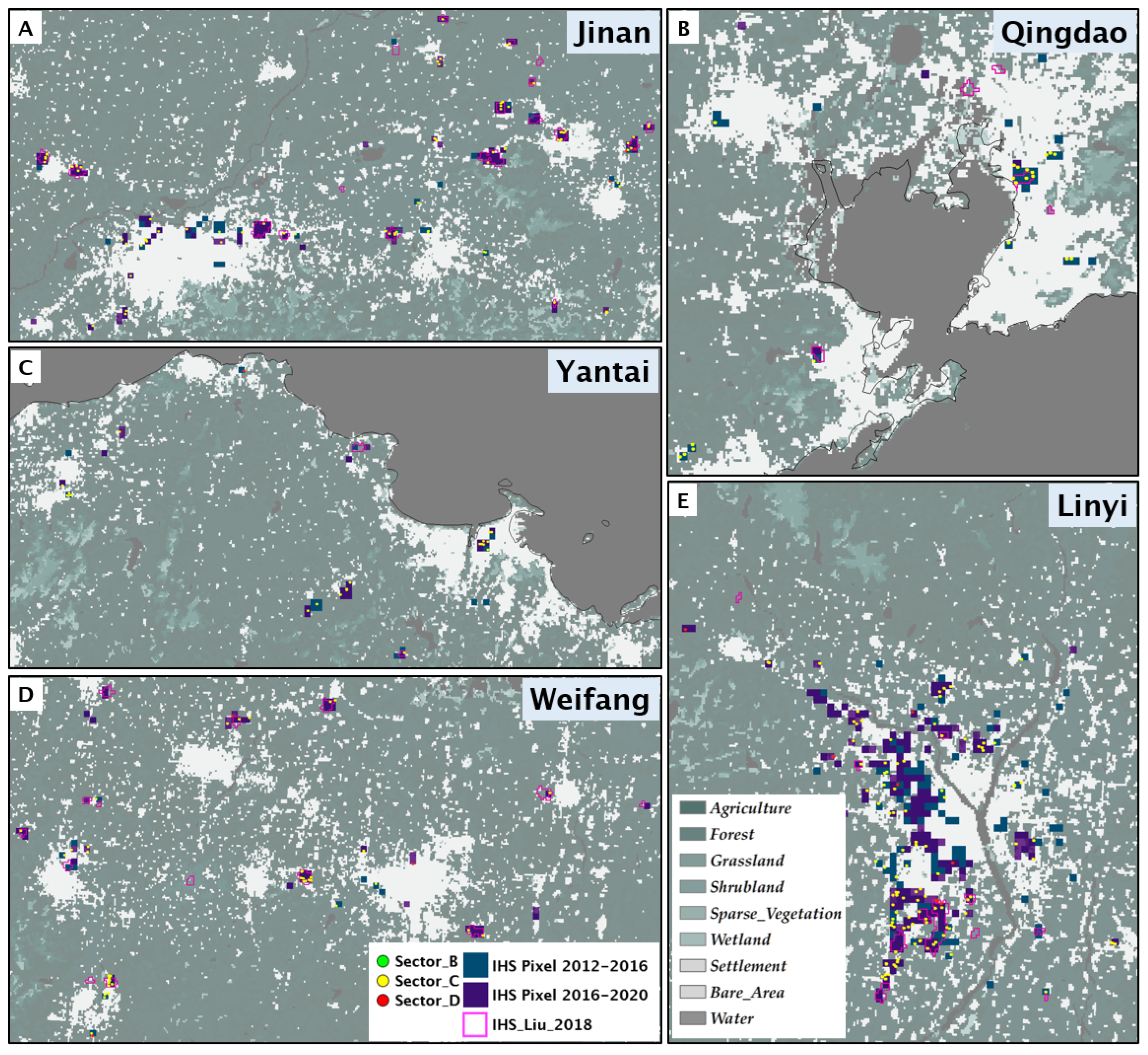
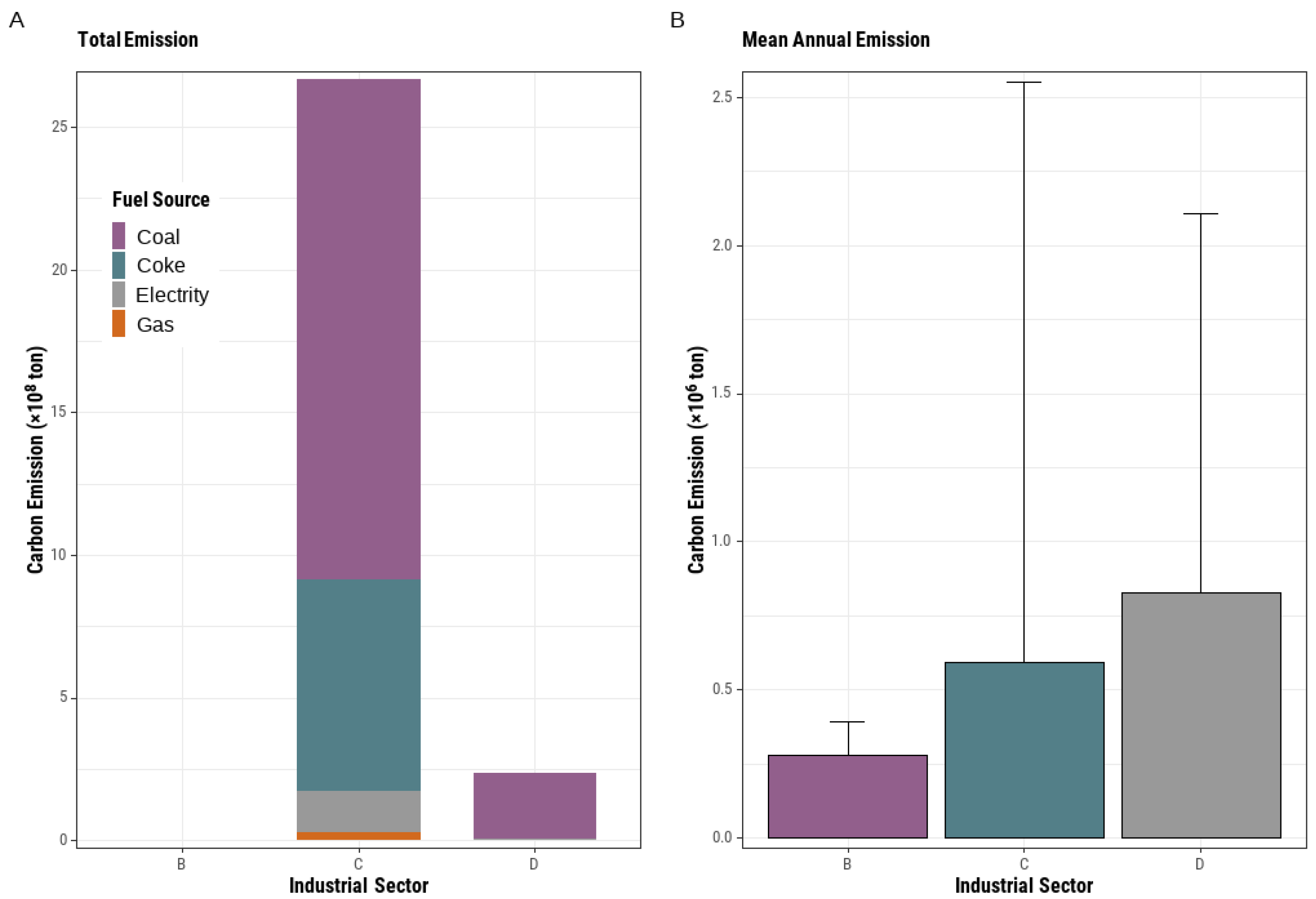
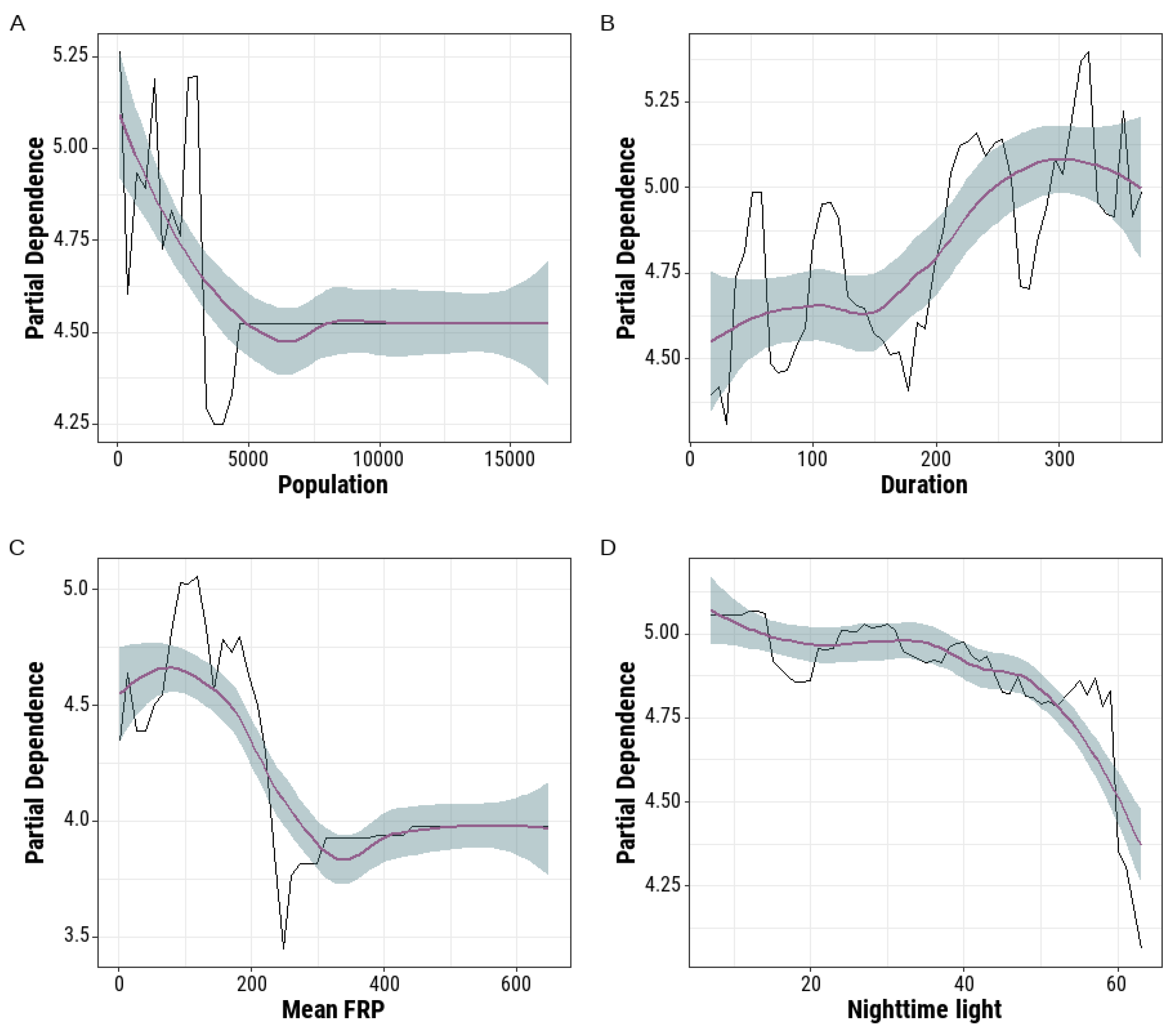
| Variable Abbreviations | Description | Mean ± SD | Data Source |
|---|---|---|---|
| Pop | Population density per unit area. | 1706.238 ± 157.819 | [51] |
| NTL | The maximum nighttime light radiance. | 42.755 ± 2.689 | [48] |
| Num_TAPs | Number of TAPs that fell in the IHS pixel. | 26.474 ± 2.776 | [14] |
| Duration | The period length in days between the start and end dates of all TAPs that fell in the IHS pixel. | 201.106 ± 6.933 | [14] |
| FRP | Accumulated fire radiative power per unit area derived from all TAPs the fell in the IHS pixel. | 42.062 ± 4.822 | [14] |
| BT4 | Accumulated brightness temperature of the I-4 Channel derived from all TAPs in the IHS pixel. | 8150.194 ± 851.2 | [14] |
| BT5 | Accumulated brightness temperature of the I-5 Channel derived from all TAPs in the IHS pixel. | 7586.415 ± 799.994 | [14] |
| Year | Thermal Anomaly Pixels | Cluster | Industrial Heat Source Pixels | ||||
|---|---|---|---|---|---|---|---|
| Raw | Retained | Fraction | Raw | Retained | Fraction | ||
| 2012 | 28,797 | 10,583 | 0.37 | 684 | 775 | 389 | 0.502 |
| 2013 | 28,110 | 11,886 | 0.42 | 699 | 821 | 504 | 0.614 |
| 2014 | 29,346 | 13,138 | 0.45 | 728 | 876 | 483 | 0.551 |
| 2015 | 26,498 | 11,172 | 0.42 | 699 | 908 | 460 | 0.507 |
| 2016 | 21,070 | 9976 | 0.47 | 452 | 681 | 425 | 0.624 |
| 2017 | 21,196 | 10,605 | 0.50 | 459 | 595 | 350 | 0.588 |
| 2018 | 20,185 | 11,560 | 0.57 | 357 | 637 | 399 | 0.626 |
| 2019 | 20,249 | 10,836 | 0.54 | 413 | 592 | 351 | 0.593 |
| 2020 | 18,242 | 10,087 | 0.55 | 377 | 553 | 363 | 0.656 |
| Mean (SD) | 23,744 (4364) | 11,201 (1001) | 0.48 (0.07) | 541 (157) | 715 (133) | 414 (58) | 0.58 (0.05) |
| Sector | IHS (2016–2020) | IHS (2012–2016) | Liu_2018 (2012–2016) | Total Inventory Corporations | |||
|---|---|---|---|---|---|---|---|
| Count | Percent | Count | Percent | Count | Percent | ||
| B | 5 | 100% | 0 | 0 | 1 | 20.0% | 5 |
| C | 1579 | 65.5% | 2068 | 85.7% | 904 | 37.5% | 2412 |
| D | 97 | 62.2% | 123 | 78.8% | 44 | 28.2% | 156 |
| Total | 1681 | 65.3% | 2191 | 85.2% | 949 | 36.9% | 2573 |
Publisher’s Note: MDPI stays neutral with regard to jurisdictional claims in published maps and institutional affiliations. |
© 2022 by the authors. Licensee MDPI, Basel, Switzerland. This article is an open access article distributed under the terms and conditions of the Creative Commons Attribution (CC BY) license (https://creativecommons.org/licenses/by/4.0/).
Share and Cite
Kong, X.; Wang, X.; Jia, M.; Li, Q. Estimating the Carbon Emissions of Remotely Sensed Energy-Intensive Industries Using VIIRS Thermal Anomaly-Derived Industrial Heat Sources and Auxiliary Data. Remote Sens. 2022, 14, 2901. https://doi.org/10.3390/rs14122901
Kong X, Wang X, Jia M, Li Q. Estimating the Carbon Emissions of Remotely Sensed Energy-Intensive Industries Using VIIRS Thermal Anomaly-Derived Industrial Heat Sources and Auxiliary Data. Remote Sensing. 2022; 14(12):2901. https://doi.org/10.3390/rs14122901
Chicago/Turabian StyleKong, Xiaoyang, Xianfeng Wang, Man Jia, and Qi Li. 2022. "Estimating the Carbon Emissions of Remotely Sensed Energy-Intensive Industries Using VIIRS Thermal Anomaly-Derived Industrial Heat Sources and Auxiliary Data" Remote Sensing 14, no. 12: 2901. https://doi.org/10.3390/rs14122901
APA StyleKong, X., Wang, X., Jia, M., & Li, Q. (2022). Estimating the Carbon Emissions of Remotely Sensed Energy-Intensive Industries Using VIIRS Thermal Anomaly-Derived Industrial Heat Sources and Auxiliary Data. Remote Sensing, 14(12), 2901. https://doi.org/10.3390/rs14122901




